
The mouflon is a wild sheep native to Cyprus, the Caspian region from eastern Turkey, Armenia, Azerbaijan, and Iran. It is thought to be the ancestor of all modern domestic sheep breeds.

The bighorn sheep is a species of sheep native to North America. It is named for its large horns. A pair of horns might weigh up to 14 kg (30 lb); the sheep typically weigh up to 143 kg (315 lb). Recent genetic testing indicates three distinct subspecies of Ovis canadensis, one of which is endangered: O. c. sierrae.
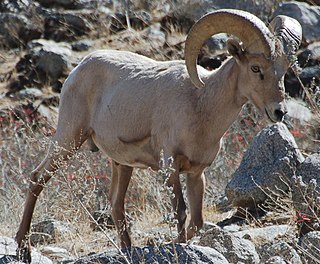
The desert bighorn sheep is a subspecies of bighorn sheep that is native to the deserts of the United States' intermountain west and southwestern regions, as well as northwestern Mexico. The Bureau of Land Management considered the subspecies "sensitive" to extinction.

Ovis dalli, also known as the Dall sheep or thinhorn sheep, is a species of wild sheep native to northwestern North America. Ovis dalli contains two subspecies: Ovis dalli dalli and Ovis dalli stonei. O. dalli live in mountainous alpine habitats distributed across northwestern British Columbia, the Yukon, Northwest Territories and Alaska. They browse a variety of plants such as grasses, sedges and even shrubs such as willow, during different times of the year. They also acquire minerals to supplement their diet from mineral licks. Like other Ovis species, the rams engage in dominance contests with their horns.

The Manx Loaghtan is a rare breed of sheep native to the Isle of Man. It is sometimes spelled as Loaghtyn or Loghtan. The sheep have dark brown wool and usually four or occasionally six horns.

The Soay sheep is a breed of domestic sheep descended from a population of feral sheep on the 100-hectare (250-acre) island of Soay in the St Kilda Archipelago, about 65 kilometres (40 mi) from the Western Isles of Scotland. It is one of the Northern European short-tailed sheep breeds.
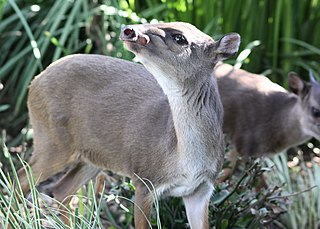
The blue duiker is a small antelope found in central, southern and eastern Africa. It is the smallest species of duiker. The species was first described by Swedish naturalist Carl Peter Thunberg in 1789. 12 subspecies are identified. The blue duiker reaches 32–41 centimetres (13–16 in) at the shoulder and weighs 3.5–9 kilograms (7.7–19.8 lb). Sexually dimorphic, the females are slightly larger than the males. The dark tail measures slightly above 10 centimetres (3.9 in). It has short, spiky horns, around 5 centimetres (2.0 in) long and hidden in hair tufts. The subspecies show a great degree of variation in their colouration. The blue duiker bears a significant resemblance to Maxwell's duiker.
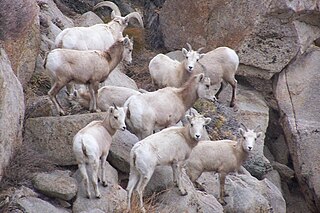
The Sierra Nevada bighorn sheep is subspecies of bighorn sheep unique to the Sierra Nevada mountains of California. A 2016 genetics study confirmed significant divergence between the three subspecies of North America's bighorn sheep: Sierra Nevada bighorn sheep, Rocky Mountain bighorn sheep and desert bighorn sheep. Sierra Nevada bighorn sheep were listed as a federally endangered subspecies in 2000. In 2016, over 600 Sierra bighorn remained in the wild.

The argali, also known as the mountain sheep, is a wild sheep that roams the highlands of western East Asia, the Himalayas, Tibet, and the Altai Mountains.

The Jacob is a British breed of domestic sheep. It combines two characteristics unusual in sheep: it is piebald—dark-coloured with areas of white wool—and it is often polycerate or multi-horned. It most commonly has four horns. The origin of the breed is not known; broken-coloured polycerate sheep were present in England by the middle of the seventeenth century, and were widespread a century later. A breed society was formed in 1969, and a flock book was published from 1972.

The Shropshire breed of domestic sheep originated from the hills of Shropshire, and North Staffordshire, England, during the 1840s. The breeders in the area used the local horned black-faced sheep and crossed them with a few breeds of white-faced sheep. This produced a medium-sized polled (hornless) sheep that produced good wool and meat. In 1855 the first Shropshires were imported into the United States (Virginia). This breed is raised primarily for meat.

The Marco Polo sheep is a subspecies of argali sheep, named after Marco Polo. Their habitat are the mountainous regions of Central Asia. Marco Polo sheep are distinguishable mostly by their large size and spiraling horns. Their conservation status is "near threatened" and efforts have been made to protect their numbers and keep them from being hunted. It has also been suggested that crossing them with domestic sheep could have agricultural benefits.

The Hebridean is a breed of small black sheep from Scotland, similar to other members of the Northern European short-tailed sheep group, having a short, triangular tail. They often have two pairs of horns. They were often formerly known as "St Kilda" sheep, although unlike Soay and Boreray sheep they are probably not in fact from the St Kilda archipelago.

The Balwen Welsh Mountain sheep is one of a number of varieties of Welsh Mountain sheep, bred for sheep farming in Wales. It has a distinctive colour pattern of a black body with white extremities. It originates in the Tywi valley in Wales. This breed is raised primarily for meat.

The Shetland is a small, wool-producing breed of sheep originating in the Shetland Isles, Scotland, but is now also kept in many other parts of the world. It is part of the Northern European short-tailed sheep group, and it is closely related to the extinct Scottish Dunface. Shetlands are classified as a landrace or "unimproved" breed. This breed is kept for its very fine wool, for meat, and for conservation grazing.

Welsh Mountain sheep are small, hardy sheep from the higher parts of the Welsh mountains. The males have horns, and the females are polled (hornless); they have no wool on the face or legs, and they have long tails. There are a number of varieties, bred for sheep farming in Wales. These are mainly colour variations, but some are being developed as separate breeds.

The Boreray, also known as the Boreray Blackface or Hebridean Blackface, is a breed of sheep originating on the St Kilda archipelago off the west coast of Scotland and surviving as a feral animal on one of the islands, Boreray. The breed was once reared for meat and wool, but is now used mainly for conservation grazing. The Boreray is one of the Northern European short-tailed sheep group of breeds.
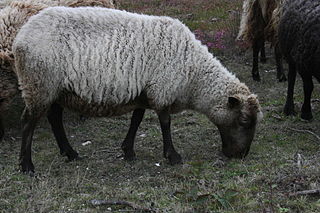
The Northern European short-tailed sheep are a group of traditional sheep breeds or types found in Northern Europe, mainly in the British Isles, Scandinavia, Greenland and the area around the Baltic. They are thought to be derived from the first sheep brought to Europe by early farmers, and for thousands of years they were the only type of sheep kept in Northern Europe. They are hardy sheep, adapted to harsh environments, but they are small and have been replaced in most areas with later types of larger, long-tailed sheep.
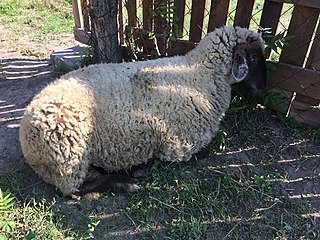
Tsigai is a Romanian sheep breed.

Ovis dalli dalli, the Dall sheep or Dall's sheep, is a subspecies of Thinhorn sheep. Like other sheep, they are large herbivores, feeding primarily on grass and other plants. They are endemic to northwestern North America, in Canada and Alaska.




















